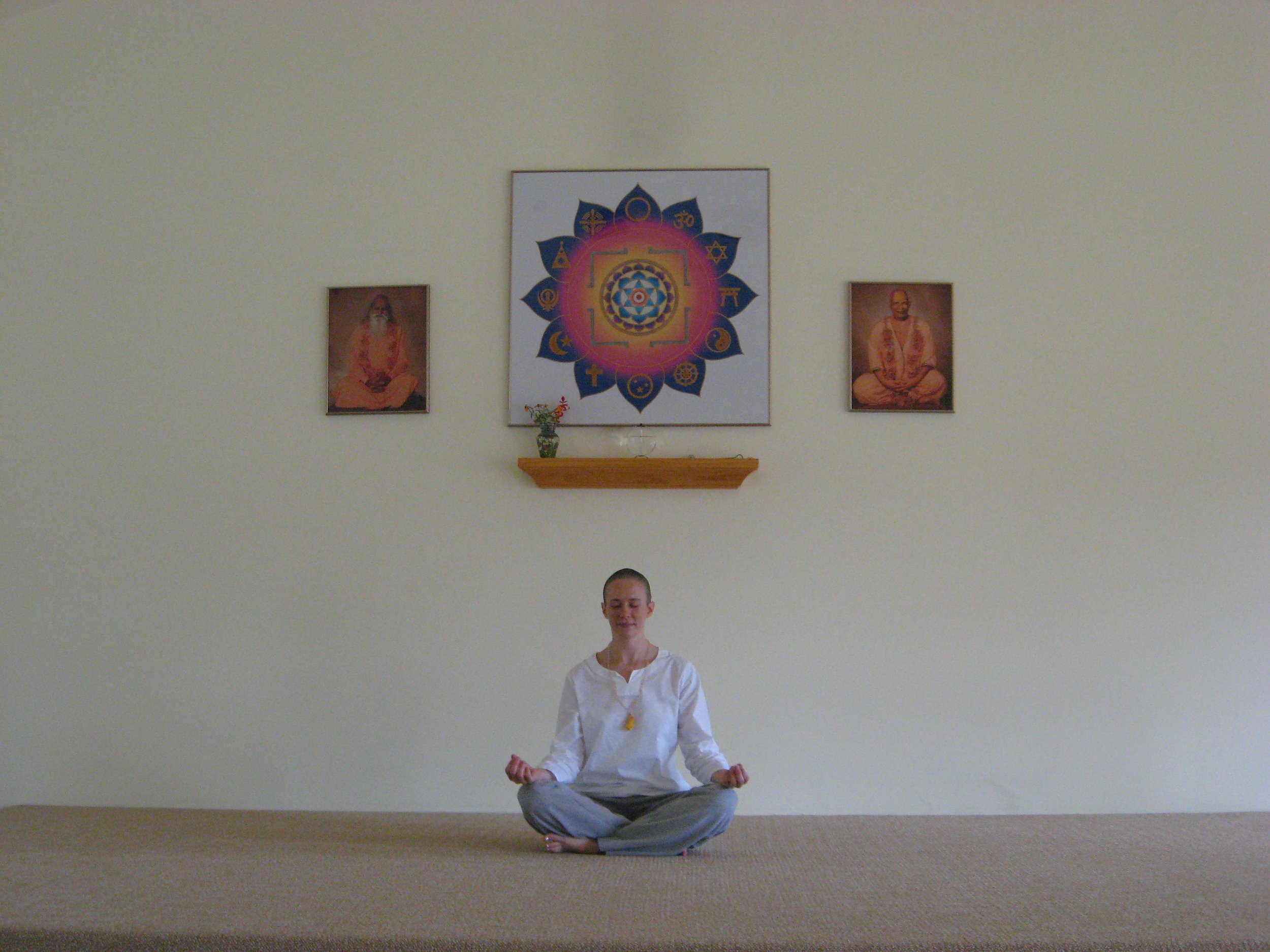Altars used to make me go wtf?
Gita meditating at Satchidananda Ashram-Yogaville in 2007
Gita is that really you?
Yup that’s your friendly-neighborhood-yoga-lady seated below an Integral Yoga altar. Summer burned hot in rural Virginia that year as did my passion for yoga. Yoga had been a private companion since high school but was brought into the public eye when I spent a month at Satchidananda Ashram-Yogaville in 2007. On paper I was there to become certified yoga teacher, but really I was indulging my long-held desire to live in a monastic community. I had only practiced Integral Yoga from videotapes—yes, tapes, omg I’m feeling so fifty years old, lol. But now I was training with veteran teachers, living with a community of householders living their yoga, and hanging with the Swamis-monks and nuns. It was like drinking through a firehose of the deep tradition of Yoga.
Before that summer altars used to freak me right out.
I’d look at them with a mixture of confusion and disdain. All of this was born of unfamiliarity, rather than any real ingrained contempt. Raised by two PhD biochemists there was very little in the way of formal religious exposure. But over time with my curiosity and my parents encouragement I began to attend services with friends, followed by the inevitable discussion when I returned home about what I observed and how the particular religion fit within both historical and modern perspectives. After all, my dad was a professor, so life experiences were not only enjoyed but also deeply examined. Our home echoed with Socrates assertion that “the unexamined life is not worth living.”
WTF is that design and who are those two dudes?
‘Cause you see that gorgeous design in between the two photos? Look at each petal on that lotus and you’ll see a representation of many faith traditions in the world. The bottom-most petal contains a few stars to represent other known faiths. And the empty petal at the top is for faiths still unknown. It is a representation of the core principle that interfaith understanding is essential if we want world peace. Side note—there’s a beautiful shrine at Yogavillebased on this design—the building is shaped like a lotus flower and has altars for each faith.
I think of those two dudes as my yoga grandfather and great-grandfather. You know how when you go into a school you’ll see pics of the founder or significant donors? This is the same thing, with a bit o’ spiritual devotion thrown into the mix. On the left is Sri Swami Satchidananda, the founder of Integral Yoga; and on the right is Sri Swami Sivananda, his teacher. Their lineage dates back to the 8th century CE and the Holy Order of Sannyas (renunciates) founded by Adi Shankaracharya. So like, old in a good way; it points our way forward precisely because it has stood the time test.
Don’t be that annoying yoga person who talks a good game but is really just a jerk.
But it ain’t just talk. That summer at Yogaville I met people from dozens of countries with all different backgrounds; engineers, teachers, Fortune 500 business dudes, busy moms…Catholic, Jewish, agnostic, atheist. We all practiced together to get to know our own selves better in order to bring this sense of equanimity and peace to the world. The folks who I met showed that it is possible to live a deeply examined life that also brings forth the best stuff into the world.
Get over yourself and serve something useful, woman!
And that’s when I got over my altar-angst. Rather than my wrong-headed assumption that an altar was an out-of-reach holy place where only men are allowed or where there is a distance put between faith and practice; I saw the altar as a place to remind my dumb-ass self to continue to practice formally AND to bring it into my life.
So I took vows to follow the path of Integral Yoga, and the vows are so simple it’s facepalm-worthy.
Here it goes: be easeful, be peaceful, and be useful.
Duh, right? But easier said than done, that’s why I took a vow to follow the path because it’s a lot easier when you have specific practices and a community. But the even more important bit is the vow to build interfaith understanding and to serve others without expecting a reward, aka: yo! Be selfless! Just serve and let whatever happens, happen.
So now get over yourself, again.
Last year I entered into the Integral Yoga Seminary, which celebrates the “Unity in Diversity” of our world by offering spiritual mentorship, retreats, and all the super omg FUN stuff like baby blessings, house blessings, and weddings.
omg squeeeee I am so looking forward to someday waving my little yoga wand and blessings someone’s home!
Somehow this daughter of two phD biochemist parents discovered her love of altars as a representation of keeping spirit alive in our lives. I’ve got something like seventeen altars in my home—from the formal to small moments of crafted beauty. They always let my eyes rest on the sacred, and remind me that however crabby I become, I can always return to cultivating my ease and peace. And I can always find a way to be useful.
Next time I pass an altar I’ll send you a little love. And invite you to allow whatever you hold sacred into your home: a flower, bird’s nest, photo of a loved one…
Sending you hope from the altars all around the world where dedicated seekers meditate; may you receive all of their hope, love, and light.
Peace to you,
Gita

